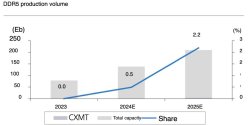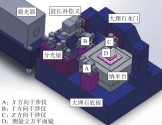You are using an out of date browser. It may not display this or other websites correctly.
You should upgrade or use an alternative browser.
You should upgrade or use an alternative browser.
Chinese semiconductor thread II
- Thread starter vincent
- Start date
Myself and others have been saying this for a while. TI and similar US companies that produce these commoditized chips like ADC/DACs would be put on the firing line. Chinese companies are buying them because the economics for replacement just doesn't make sense. However, the continued belligerence of American sanctions changes that equation. American companies will lose easy business for nothing.[News] China’s Probe into U.S. Chip Subsidies May Target Texas Instruments
are you simply not capable of change from x.com to twitter.com to make it easier for this thread? another infraction like this and you can't post on this thread for a month.
View attachment 144151
This guy is having a paranoia about CXMT as of late and it's an amazing accomplishment by that company. I'm sure CXMT is using some of the same loopholes SMIC used to import SME to develop below 18.5nm DRAM.
But really interesting to see how american administration in turning a blind eye on them.
I remember when they got the news on YMTC surpassing Samsung they were sanctioned very quickly
translation of that article about CXMT getting into D1z. A while back, hvpc mentioned to me that they were making good progress with it, so there has been several prove now that they are able to do this.
D1z+DDR5 news seem to be complete now. They are able to do it for around 16nm. And based on roadmap. D1z is sufficient for HBM3 based on what we saw with SK and Samsung.
So the matter now is in fact to build up DDR5 capacity. something to think about with respect to CXMT share of DDR5

this is good news. Micron got to D1b without EUV. CXMT is at good enough yield with D1z and whatever tools they got from before the October sanctions came + whatever non-American tools they have now. I'd assume they can get to D1a by 2026 as long as AMEC/NAURA tools continue to improve.Changxin Memory (CXMT), recently began mass production of products using the D1z (16 nanometers or less) of the 10-nanometer (1 nm = 1 billionth of a meter) DRAM process. It is reported that there is a growing sense of crisis that competition in leading products may intensify in the future due to the low-price offensive of Chinese memory companies.
■ Samsung conducts on-site investigation in pursuit of CXMT technology
According to the semiconductor industry on the 22nd, Samsung Electronics has started to grasp the trend after recently seeing that China's CXMT is mass producing double date rate 5 (DDR5) using the D1z of the 10-nanometer DRAM process, which is a leading process. As the 'super gap' technology competition in the semiconductor industry intensifies, semiconductor companies including Samsung Electronics are also putting a lot of effort into understanding their competitors' technological capabilities.
The 10nm DRAM process narrows the circuit width in the order of D1x → D1y → D1z. As the circuit width narrows, more cells (data storage units) can be integrated in the same area, which increases density and reduces power consumption. The subsequent generations, D1a to D1b and D1c, are called next-generation processes. The industry sees that if CXMT, which was producing products with the D1x (18nm) and D1y (17nm) level of technology, has begun to introduce the D1z process in earnest, it means that it has narrowed the technological gap quickly.
D1z+DDR5 news seem to be complete now. They are able to do it for around 16nm. And based on roadmap. D1z is sufficient for HBM3 based on what we saw with SK and Samsung.
So the matter now is in fact to build up DDR5 capacity. something to think about with respect to CXMT share of DDR5

With a total investment of 1.3 billion yuan, Bailixin Semiconductor's 6-inch MEMS wafer manufacturing line project was launched in Zhejiang
The 6-inch MEMS wafer manufacturing line project of Bailixin Semiconductor (Zhejiang) Co., Ltd. (hereinafter referred to as Bailixin Semiconductor) have been approved, and the project construction period is from 2024 to 2026. Bailixin Semiconductor was established on July 31, 2024 with a registered capital of 100 million yuan. The company is located in Lishui City, Zhejiang Province, and the legal representative is Zhang Chengrui.
The total investment of the project is 1.3 billion yuan, with an investment of 600 million yuan in the first phase of the project, including 450 million yuan in fixed asset investment. The leased factory building is about 10,000 square meters, mainly to build a production line with an annual output of 72,000 6-inch MEMS wafers, producing MEMS chips, e-cigarette chips and vehicle-mounted sensor chips, etc.; the second phase of the project will invest 700 million yuan, including 600 million yuan in fixed asset investment, and the planned land area is about 50 acres, mainly to build a MEMS wafer production line.
In addition to MEMS chips, e-cigarette chips and vehicle-mounted sensor chips , Bailixin Semiconductor's products also include laser scanning micro display modules (mainly used in smart glasses, head-mounted displays, micro projectors, etc.), Bluetooth dual-mode and low-power chips, biosensors (mainly used in medical diagnosis, biological research, environmental monitoring, etc.), etc.
The total investment of the project is 1.3 billion yuan, with an investment of 600 million yuan in the first phase of the project, including 450 million yuan in fixed asset investment. The leased factory building is about 10,000 square meters, mainly to build a production line with an annual output of 72,000 6-inch MEMS wafers, producing MEMS chips, e-cigarette chips and vehicle-mounted sensor chips, etc.; the second phase of the project will invest 700 million yuan, including 600 million yuan in fixed asset investment, and the planned land area is about 50 acres, mainly to build a MEMS wafer production line.
In addition to MEMS chips, e-cigarette chips and vehicle-mounted sensor chips , Bailixin Semiconductor's products also include laser scanning micro display modules (mainly used in smart glasses, head-mounted displays, micro projectors, etc.), Bluetooth dual-mode and low-power chips, biosensors (mainly used in medical diagnosis, biological research, environmental monitoring, etc.), etc.
Establishment of a dual traceability link metrology standard device for micro-nano displacement positioning calibration.
- Shenzhen Institute of Metrology
- China National Institute of Metrology
- School of Physical Science and Engineering, Tongji University
- National Integrated Circuit Micro-Nano Testing Equipment Industry Metrology and Testing Center
summary:
Micro-nano positioning technology is one of the key technologies in the field of cutting-edge science and engineering technology. Among them, the displacement calibration of micro-nano positioning platforms occupies an important position in the field of precision measurement. The National Institute of Metrology has developed a dual traceability link metrology standard device for micro-nano displacement positioning calibration and established it as my country's metrology standard. The device includes a laser interferometer micro-nano displacement positioning calibration device and a grating diffraction interferometer micro-nano displacement positioning calibration device. The laser interferometer calibration device realizes direct and comprehensive calibration of the nano-micro displacement platform through a six-degree-of-freedom laser interferometer calibration system. In this traceability link, the value is traced back to the wavelength reference defined by meters through a laser interferometer; the grating diffraction interferometer calibration device is based on a one-dimensional nano grating standard material. In this traceability link, the value is traced back to the wavelength reference defined by meters through the grating pitch. The dual traceability link metrology standard device meets the diversified application needs of micro-nano positioning calibration and enhances the comprehensiveness and reliability of the traceability method, ensuring high-precision measurement of micro-nano displacements in the field of integrated circuit lithography and other fields, and precision assembly measurement of key components in the aerospace industry. The establishment of this metrology device provides important technical support for the development of my country's micro-nano positioning technology.
Interesting see Windows XP running along side litho gratings interferometers.


Micro-nano positioning technology is one of the key technologies in the field of cutting-edge science and engineering technology. Among them, the displacement calibration of micro-nano positioning platforms occupies an important position in the field of precision measurement. The National Institute of Metrology has developed a dual traceability link metrology standard device for micro-nano displacement positioning calibration and established it as my country's metrology standard. The device includes a laser interferometer micro-nano displacement positioning calibration device and a grating diffraction interferometer micro-nano displacement positioning calibration device. The laser interferometer calibration device realizes direct and comprehensive calibration of the nano-micro displacement platform through a six-degree-of-freedom laser interferometer calibration system. In this traceability link, the value is traced back to the wavelength reference defined by meters through a laser interferometer; the grating diffraction interferometer calibration device is based on a one-dimensional nano grating standard material. In this traceability link, the value is traced back to the wavelength reference defined by meters through the grating pitch. The dual traceability link metrology standard device meets the diversified application needs of micro-nano positioning calibration and enhances the comprehensiveness and reliability of the traceability method, ensuring high-precision measurement of micro-nano displacements in the field of integrated circuit lithography and other fields, and precision assembly measurement of key components in the aerospace industry. The establishment of this metrology device provides important technical support for the development of my country's micro-nano positioning technology.
Interesting see Windows XP running along side litho gratings interferometers.


Lianyungang plans to build a 10,000-ton electronic grade high-purity quartz sand R&D and production project.
It is reported that the project was invested 100 million yuan by Lianyungang Xugao Quartz Technology Co., Ltd. The project purchased production equipment such as magnetic separators, air compressors, flotation machines, water makers, centrifuges , etc., and formed an annual production capacity of 10,000 tons of electronic grade silicon materials through the process of raw materials (quartz ore) → ore washing → wet crushing → air impact crushing-acid washing (outsourcing) → flotation-drying → magnetic separation-packaging.
It is built in two phases. The designed production capacity of Phase I and Phase II is 5,000 tons/year. The product is electronic-grade silicon material (purity ≥ 99.999%).
Maxke Electronics' 8-inch silicon epitaxial wafer project is currently undergoing equipment commissioning
According to Luoyang Media, the Maxike Electronics project to produce 3.6 million 8-inch silicon epitaxial wafers annually in Jianxi District has been accelerated recently. Currently, the equipment has been installed and debugging is underway.
It is reported that the total investment of the project exceeds 1.4 billion yuan, with a construction area of over 50,000 square meters. The construction content includes the addition of epitaxial workshops, cleaning workshops and other production sites, production equipment, office space, and expansion of public facilities. After the project is completed and reaches full production, it will produce 3.6 million 8-inch silicon epitaxial wafers annually, helping Henan to seize the lead in emerging industries, promote the localization of semiconductor materials, and accelerate the rise of China's Epitaxial Wafer Industry.

interesting note from SK call
Significant capacity by Chinese suppliers hurting pricesDRAM has entered a decline since Q4 2024, driven by continued weakening demand in major applications since the second half of last year. High industry inventory levels and price declines for DDR4 and LPDDR4, which are impacted by Chinese suppliers, are particularly notable.
Koreans are shifting focus to HBM and not participating in DRAM price war, it looks likeWhile HBM is leading AI memory growth this year, general DRAM is expected to go through a gradual adjustment. Investments are being focused on HBM, and we are proceeding cautiously. With AI as the priority, we anticipate market behavior to differ from past cycles.
Revenue share of DDR4/LPDDR4 going down by more than 50% for SK. Huge growth likely for CXMT and others.• While high-performance, high-spec DRAM products like HBM and DDR5 will remain in tight supply this year, demand for legacy products like DDR4 and LPDDR4 is expected to decrease, further decoupling product-specific demand. • SK Hynix plans to focus on HBM and DDR5 while reducing DDR4/LPDDR4 production and normalizing inventory. • As a result, DDR4/LPDDR4 revenue share is expected to shrink significantly from 20% last year to single digits this year.
SK is being overly optimistic about need for higher end HBM here. I think while HBM3 will be on Nvidia chips, it doesn't give you all that much more. I can see Huawei continue to go HBM2E on chips it sells for inference even after HBM3 domestic production starts next year.We disagree. While lower-spec HBM was initially considered sufficient for AI inference applications, the importance of high-spec HBM is now increasing.
so SK is still optimistic about their more densely packed DDR5 vs CXMT. But they are moving to D1c, which is 3 generations ahead of D1z that CXMT is mass producing now.What is your position on Chinese DRAM manufacturers? Do you think they can enter the high-performance memory market such as DDR5 and HBM? • Since the second half of last year, Chinese DRAM suppliers have increased their supply of DDR4 and LPDDR4 products, coupled with declining demand, leading to continued price drops in legacy products. • Recently, there have been reports discussing the development and sale of DDR5 by Chinese manufacturers, raising concerns in the market. • However, compared to the processes applied by major suppliers to produce high-performance products, there is still a significant gap. The performance and quality of DDR5 based on their current processes will show a clear difference. • With escalating trade restrictions on China, Chinese manufacturers are likely to face even more uncertainties in securing advanced fabs. • SK Hynix plans to continue developing advanced fabs and preparing high-performance products in a timely manner. We aim to maintain our competitive edge by preparing a variety of AI memory products, including HBM, to stay ahead of emerging competitors.
very few questions on NAND, it would seem to me that they are not excited to talk about a sector that faces overly strong Chinese competition

